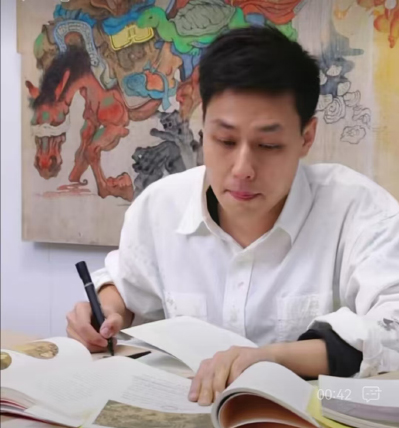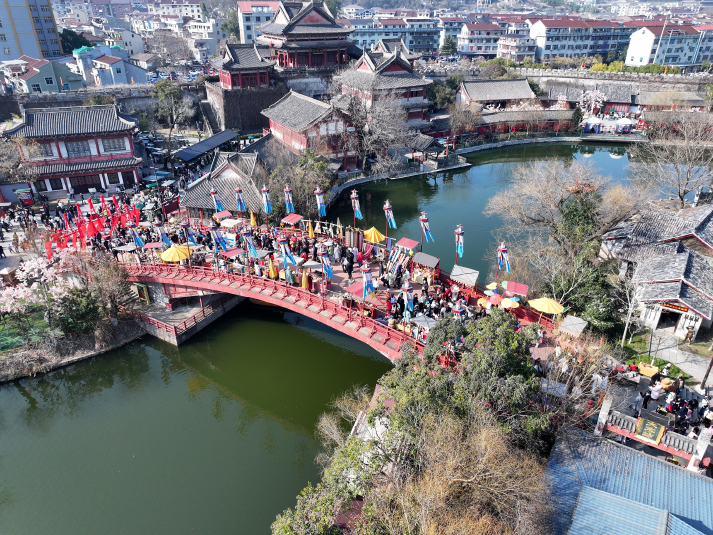| China |
| From scroll to spotlight | |
|
|
 Chen Hanyu portrays the characters from the scroll Along the River During the Qingming Festival and shares his process on social media (SCREEN SHOT)
Hundreds of characters depicted in an ancient scroll painting have sparked a wave of inspiration among contemporary writers and artists, who are breathing life into the once-static artwork, giving names to these figures and crafting intricate stories around them. Illustrating urban life in 12th-century Bianjing (or modern-day Kaifeng in Henan Province), capital of the Northern Song Dynasty (960-1127), the scroll Along the River During the Qingming Festival, created by artist Zhang Zeduan (1085-1145), measures over 5 meters in length and nearly 25 centimeters in width. Occurring in early April, the Qingming Festival is a traditional Chinese holiday dedicated to ancestor worship and tomb sweeping. The masterpiece features a vast array of characters representing more than 100 professions and many different segments of society at the time. Reviving the nameless Chen Hanyu, a young art history graduate from Shanghai University, has become fascinated with these nameless figures and their diversity. In March 2024, he launched his own account on Douyin, China's version of TikTok, to tell the stories of these commonplace characters. He named each figure, wrote short biographies and illustrated their stories, which he then carved onto woodblocks, all the while documenting the process on camera. "I want to give these minor figures the chance to be the protagonists for once," said Chen. Chen's first character, whom he named "Sun Si," appears in the original painting holding what looks like chopsticks in his right hand and two bowls of rice in his left, walking in front of a restaurant. Chen reimagined him as a delivery man for the restaurant, a profession that indeed existed during the Northern Song Dynasty. In Chen's narrative, Sun secretly admires a woman from a nearby brothel but lacks the courage to confess his feelings. He works tirelessly to earn money, hoping one day to marry her, unaware that she has no interest in him. The first video telling this story received a warm and affectionate response from viewers. Chen believes that the lives of these minor figures are marked by unfulfilled aspirations. In his videos, he said that his decision to focus on them stems from his own life's disappointments—failing his first college entrance exam, also known as gaokao, unsuccessful graduate school applications, and a failed business venture. "When it comes to historical figures, the focus is usually on emperors and generals. I want these overlooked characters to take the spotlight in my videos," he explains. In 2017, while studying artifact restoration at the Shanghai Institute of Visual Arts, Chen was assigned by his teacher to restore a painting from the Ming Dynasty (1368-1644). In addition to repairing the edges, Chen was tasked with recreating the missing facial expressions of a lady in the portrait. This experience led him to realize that every character in a painting should have their own emotions. When creating the minor characters from the long scroll, Chen adapts and expands on their stories using historical materials, imagining what their lives might have been like during the Northern Song Dynasty. He sets his works apart from the subtle style of the original scroll by employing more lively color schemes and detailed traditional Chinese painting technique. Managing the entire process alone, Chen has completed 22 characters in 10 months. When asked by online followers when he will finish depicting hundreds of characters, he responded, "I'll take my time. The most important thing right now is to tell the stories well and paint them well." Chen hopes to eventually organize an exhibition of these works, sharing the stories of these characters with a wider audience.  A scene from the ancient scroll Along the River During the Qingming Festival is recreated in Hengdian Town, Zhejiang Province, on February 10, 2024. The town is home to a famous film and television production base (XINHUA)
Epic adaptation In contrast to Chen's mosaic-like narratives of minor characters, Chengdu-based writer Ye Wenbiao's approach is much grander. He has created a story that stars over 800 individuals depicted in a painting, and over the course of more than a decade, he completed a six-volume series of mystery novels set in the Northern Song Dynasty. Ye's fascination with Along the River During the Qingming Festival began more than 10 years ago during a trip to Kaifeng, where he encountered a replica of the painting. "The moment the scroll unfurled, I was stunned. The characters and landscapes seemed to come alive before my eyes. It felt like a fateful encounter, calling me to write their stories," he told ThePaper.cn, a Shanghai-based news portal. Both the artistic techniques of the painting itself and the depiction of Northern Song society greatly inspired his passion for writing. He began by intensively studying the scroll and the dynasty's history. Initially, he spent five years digging through piles of historical materials, followed by three years conceptualizing and structuring his ideas. He then dedicated seven years to writing, ultimately completing the six-volume historical mystery series Riverside Code at the Qingming Festival. "Modern detective novels have been around for nearly a century but are limited in scope; a single work can hardly accommodate many characters, with 30 perhaps being the limit, thus lacking the expansive narrative space of other genres," he said. "I've always wanted to break this limitation and write a detective novel rich in characters, complex in plot and deep in background." The challenges of this novel, as he stated, are not on tricks but on the layout, on how to integrate nearly 1,000 characters, hundreds of cases, the painting, and Northern Song history into a cohesive whole. His series feature over 800 characters, each with their own meticulously crafted names and backgrounds. He connects and analyzes every minute detail in the painting, supplemented by a wealth of historical facts, to compile compelling mystery stories. In his books, he narrates over 20 types of detective tricks and uses a main murder case on a boat to link more than 80 other cases, weaving an incredibly intricate plot. Upon its release, the first book quickly became a national bestseller. It drew the attention of multiple film and television companies, all vying for the rights to adapt it into a screenplay. The intellectual property (IP) also sparked a battle among various parties for animation and game adaptation rights, making it one of the strongest IPs in recent years. In June 2024, a stage drama based on the novel, produced by the Shanghai Dramatic Arts Center, premiered in Shanghai. The production will begin touring over 10 cities nationwide starting in March. On December 16, 2024, a television series adapted from the novels, Riverside Scene at the Qingming Festival, aired on Central China Television. Director Yang Fan mentioned that to shoot this series, a 10-acre Northern Song Dynasty architectural site was constructed in Suzhou, Jiangsu Province. Every tree, building, rainbow bridge and stretch of the Bian River—a section of the Grand Canal of the Sui (581-618) and Tang (618-907) dynasties—was recreated based on the original painting, making it the largest and most authentic Northern Song Dynasty set in China. "This drama takes viewers nearly 1,000 years back in time to show how people lived then. Despite the passing of centuries, the basic aspects of life haven't changed," Wang Qinan, the producer and chief screenwriter of the series, told Shandong Daily newspaper. "Life may look different now, but the joys and sorrows people experienced then are the same as those we feel today. These are the simple joys that everyone can relate to." BR Copyedited by Elsbeth van Paridon Comments to yuanyuan@cicgamericas.com |
|
||||||||||||||||||||||||||||
|